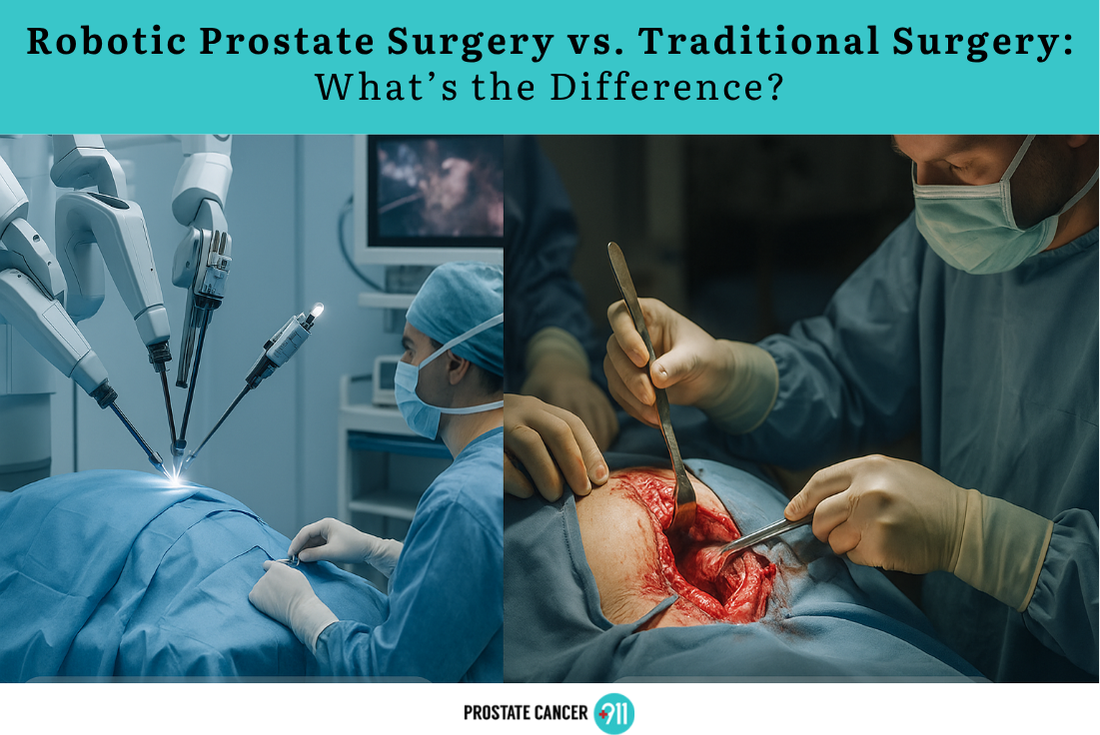 Introduction
Introduction
When facing a prostate cancer diagnosis, choosing the right treatment can feel overwhelming. Among the most common and effective treatments for localized prostate cancer is surgery—but what many patients don’t realize is that there are different types of surgical approaches, each with distinct outcomes and risks.
In this guide, world-renowned prostate surgeon Dr. David Samadi—developer of the SMART Robotic Prostatectomy technique—explains the critical differences between traditional open prostate surgery and robotic prostatectomy. If you’re considering prostate surgery, understanding these differences can help you make a more confident, informed decision.
What Is a Prostatectomy?
A prostatectomy is the surgical removal of the prostate gland, often done to treat prostate cancer. It can be performed using:
- Traditional Open Surgery
- Laparoscopic Surgery
- Robotic-Assisted Surgery (Robotic Prostatectomy)
All methods aim to remove the cancer while preserving urinary and sexual function—but how they’re performed, and the results they yield, can vary significantly.
Traditional Open Prostate Surgery
What It Involves:
- A large incision (6–10 inches) is made in the lower abdomen.
- The surgeon manually removes the prostate.
- Often involves cutting through muscle and tissue.
Risks and Considerations:
- Greater blood loss
- Longer hospital stay
- Higher risk of infection and pain
- Slower return to normal activities
- Increased risk of damaging surrounding nerves
Robotic Prostatectomy (Minimally Invasive)
What It Involves:
- Small keyhole-sized incisions (5–6 total)
- Surgeon operates using the da Vinci® Surgical Robot
- Enhanced 3D visualization and micro-precision tools
- Surgeon is in full control—robot doesn’t operate independently
Dr. David Samadi’s SMART (Samadi Modified Advanced Robotic Technique) is a specialized approach to robotic surgery that preserves vital nerve structures while ensuring complete cancer removal.
Benefits of Robotic Surgery for Prostate Cancer
The rise in robotic prostatectomy is no accident. It offers numerous advantages over traditional surgery, especially when performed by a highly experienced surgeon like Dr. Samadi:
| Category | Traditional Surgery | Robotic Prostatectomy |
| Incision Size | Large (6–10 inches) | Small (1 cm x 5–6 incisions) |
| Blood Loss | Higher | Minimal |
| Hospital Stay | 2–4 days | Usually within 24 hours |
| Recovery Time | 6–8 weeks | 2–3 weeks |
| Continence Outcomes | Lower urinary control rates | Over 95% regain urinary control |
| Sexual Function | Variable | Higher preservation with SMART |
| Cancer Control | Effective | Highly effective with fewer risks |
The SMART Technique by Dr. David Samadi
Dr. Samadi’s SMART Robotic Prostatectomy is a globally recognized technique that combines the cancer-fighting success of traditional open surgery with the precision of robotic technology.
What Makes SMART Different?
✅ No cutting of the neurovascular bundles
✅ No use of cautery near delicate structures
✅ Greater preservation of urinary and sexual function
✅ Shorter operative time and quicker recovery
Dr. Samadi performs every surgery himself, ensuring consistency, safety, and the best possible results.
Patient Experience: What to Expect with Robotic Surgery
Pre-Surgery
- PSA test, biopsy review, MRI imaging
- Comprehensive consultation with Dr. Samadi
- Preoperative planning tailored to each patient’s anatomy and goals
Day of Surgery
- Performed at a top-rated NYC surgical facility
- General anesthesia; surgery takes 1.5–2.5 hours
- Patients walk the same day and go home within 24 hours
Recovery
- Catheter in place for 5–7 days
- Return to work in 1–2 weeks (desk jobs)
- Full return to normal activities in 3–4 weeks
- Long-term follow-up with Dr. Samadi and team
Robotic Prostatectomy Outcomes: What the Data Shows
Clinical studies and Dr. Samadi’s own patient records show exceptional outcomes with robotic surgery:
- Cancer-Free Rates: Comparable or superior to traditional methods
- Urinary Control: 95%+ regain continence
- Sexual Function: Higher preservation when SMART is used
- Complication Rates: Lower than open surgery when performed by an expert
“With the SMART technique, we don’t just remove the cancer—we preserve quality of life.” – Dr. David Samadi
Frequently Asked Questions
Is robotic prostatectomy safer than traditional surgery?
Yes. Robotic prostatectomy typically results in less blood loss, fewer complications, and a quicker recovery. It is particularly safe in the hands of an experienced robotic surgeon like Dr. Samadi.
Will I still be able to have normal sexual function?
Dr. Samadi’s nerve-sparing technique greatly increases the chance of preserving sexual function. Results vary based on age, baseline function, and cancer severity.
Can I get a second opinion?
Absolutely. Dr. Samadi encourages all patients to seek second opinions and offers comprehensive consultations for men across the U.S. and internationally.
Why Choose Dr. David Samadi?
With over 7,000 successful robotic surgeries and patients from more than 45 countries, Dr. Samadi is one of the most experienced prostate cancer surgeons in the world.
At Prostate Cancer 911 in New York City, you’ll receive:
✅ Concierge-level personalized care
✅ Same-day consultations and rapid diagnostics
✅ Surgeon-performed operation from start to finish
✅ Long-term follow-up and guidance post-surgery
Conclusion: Which Surgery Is Right for You?
The choice between robotic prostate surgery and traditional surgery comes down to more than just tools—it’s about outcomes, recovery, and quality of life. While both can effectively treat prostate cancer, robotic surgery, especially using Dr. Samadi’s SMART technique, offers:
- Less pain
- Faster healing
- Better urinary and sexual outcomes
- Outstanding cancer control
If you’re seeking precision, confidence, and expertise, robotic prostatectomy with Dr. Samadi may be the best choice for your health and future.
Book a Consultation with Dr. Samadi
📍 Prostate Cancer 911
485 Madison Ave, 21st Floor
New York, NY 10022
📞 Call Now: (212) 365-5000
🌐 www.prostatecancer911.com
Experience the future of prostate cancer surgery—today.
Choose robotic precision. Choose faster recovery. Choose Dr. David Samadi.

 Introduction
Introduction